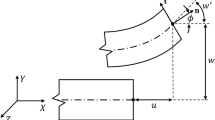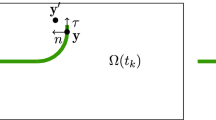Abstract
Non-linear finite element results from a round robin are compared with empirical and experimental data obtained for three types of geometries: compact specimen, three-point bend specimen and a center-cracked panel subject to uniaxial loading. The solution parameters to be compared in various forms are: applied load, clip gauge displacement, RiceJ-integral (with no limit placed on method of calculation),K 1 crack opening profiles and plastic zone development.
Résumé
Les résultats d'éléments finis non linéaires résultant d'une consultation circulaire sont comparés avec des données empiriques et expérimentales obtenues pour trois types de géométrie: éprouvette compacte, éprouvette de flexion en trois points et panneau à fissure centrale soumis à une charge uniaxiale. Les paramètres de la solution qui doivent être comparés dans les différentes formes sont: la charge appliquée, le déplacement d'un extensiomètre, l'intégraleJ (sans réserve sur sa méthode de calcul), KI, les profils d'ouverture de fissure ainsi que le développement de la zone plastique.
Similar content being viewed by others
References
W.K. Wilson and J.R. Osias,International Journal of Fracture 14 (1978) R98-R109.
J.G. Merkle and H.T. Corten,Journal of Pressure Vessel Technology 96 (1974) 286–292.
J.R. Rice,Journal of Applied Mechanics 35 (1968) 379–386.
J.R. Rice, inFracture and Advanced Treatise, Ed. H. Liebowitz, Volume II (1968) 191–311.
D.M. Parks inProceedings of the First International Conference of Numerical Methods in Fracture Mechanics Swansea University, U.K. (1978) 464–478.
J.D.G. Sumpter and C.E. Turner, inCracks and Fracture, ASTM STP 601 (1976) 3–18.
Standard Method of Test For Plane Strain Fracture Toughness of Metallic Materials. ASTM E-74 (1974).
F.J. Bradshaw and C. Wheeler, “The Crack Resistance of Some Aluminium Alloys and the Prediction of Thin Section Failure”, Report 73191, Royal Aircraft Establishment, Farnbourgh, England (1974).
R.S. Barsoum,International Journal for Numerical Methods in Engineering 10 (1976) 25–37.
M. Shiratori and T. Miyoshi, inProceedings of the Second International Conference of Numerical Methods in Fracture Mechanics Pineridge Press, Swansea, U.K. (1980) 417–431.
J.E. Srawley and B. Gross,Engineering Fracture Mechanics 4 (1972) 587–589.
J.R. Haigh and C.E. Richards, Report RD/L/M 461, Central Electricity Generating Board, U.K. (1974).
G. Irwin,Journal of Applied Mechanics 24 (1957) 361–364.
D.P. Rooke and D.J. Cartwright, inCompendium of Stress Intensity Factors (1976) 84.
W.T. Evans, M.F. Light and A.R. Luxmoore,Journal of the Mechanics and Physics of Solids 28 (1980) 167–189.
Author information
Authors and Affiliations
Rights and permissions
About this article
Cite this article
Bleackley, M.H., Luxmoore, A.R. Comparison of finite element solutions with analytical and experimental data for elastic-plastic cracked problems. Int J Fract 22, 15–39 (1983). https://doi.org/10.1007/BF00960097
Received:
Revised:
Issue Date:
DOI: https://doi.org/10.1007/BF00960097




